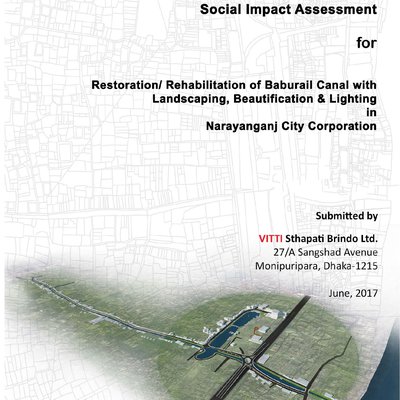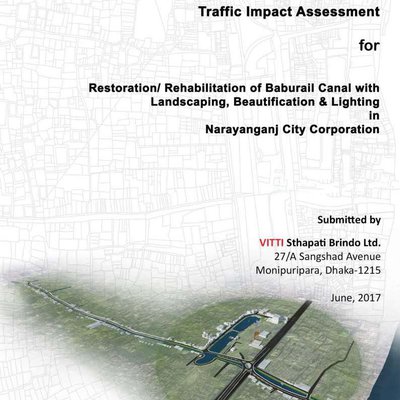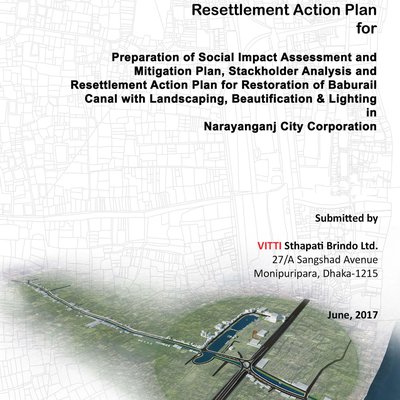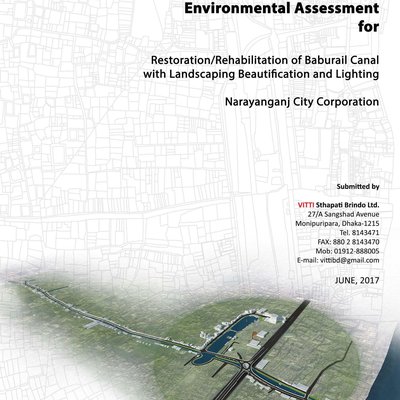

Description
Narayanganj, historically known as the Dundee of the East, is a city built around rivers and canals, with the Baburail Canal once serving as a major trade route between the Dhaleshwari and Shitalakshya rivers. Over time, however, the canal became overwhelmed with waste, encroachment, and neglect, fading from the city's water heritage. The project seeks to restore the canal, reestablishing the hydrological link between the two rivers and revitalizing the city’s waterfront, while preserving its social and cultural significance.
The restoration began with active community engagement, involving local residents, policymakers, and stakeholders in participatory planning. Environmental and Social Impact Assessments, along with biodiversity studies, were conducted to ensure the project’s sustainability. In a remarkable display of community cooperation, most encroachers voluntarily relocated, setting a model for socially inclusive urban regeneration.
The 405-meter stretch of restored canal now serves as a series of interconnected public spaces that blur the boundaries between land and water. Floating decks, ghats, shaded walkways, and stepped edges create spaces for people of all ages and abilities. Special features, such as dedicated women’s seating, children’s play areas, and senior citizen-friendly exercise zones, promote social sustainability and ensure equitable access for all members of society. Raised earth mounds, which were originally used as waste dumping zones, have now been transformed into spaces for recreational activities, including a boat club, indoor pool, and gym. These mounds help preserve the landscape’s memory while providing new spaces for leisure and activity. Ecological layering along the canal’s edge, with varying planting densities and moisture levels, has created microhabitats that support biodiversity and improve the area’s environmental health. The introduction of local flowering and native plant species has enhanced the ecological quality of the space, inviting wildlife back into the area and contributing to passive cooling. Water control systems at both ends of the canal regulate the flow, addressing contamination issues and supporting urban resilience. A network of trellised paths, footbridges, and permeable surfaces promotes non-motorized movement, blending recreation with ecological interaction.
The project not only restores a key waterway but also transforms the area into a vibrant, inclusive public space, demonstrating how nature can be an active partner in creating sustainable, human-centered urban spaces.
Information
Rejuvenate Gymkhana Sheikh Rasel Park and Baburail Canal Restoration, Narayanganj
Client:
Narayanganj City Corporation
Location:
Narayanganj
Project Team:
Ar. Md. Ishtiaque Zahir (Team Leader)
Ar. Md. Iqbal Habib
Ar. Mehedi Hasan
Civil Engineer:
Md. Tofazzel Hossain
Md . Aynal Gazi
Urban Planner:
Md. Maksudur Rahman
Environmental Specialist:
Dr. J.C Saha
Social Development Specialist:
Mr.Mohidul Haq Khan
Resettlement Specialist:
Md. Izazul Haq
Social Expert:
Md.Khalid Hasan
Environmental & Drainage Engineer:
Shadat Hossain
Project Timeline:
2017-2023
Files




For further information about this project, please contact us.
Video
For further information about the project Zimkhana Park and Baburail Canal Restoration, Narayanganj